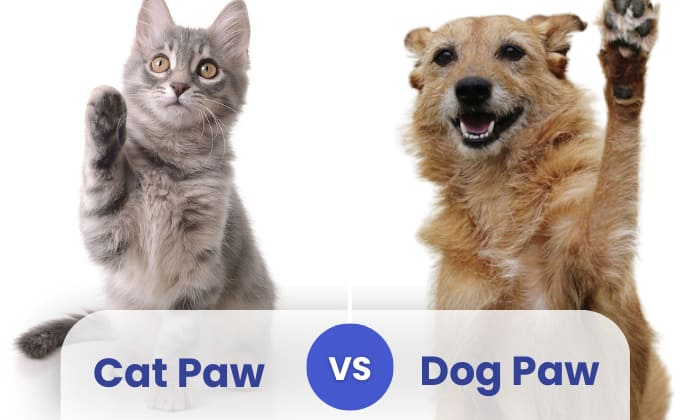Cat paws are softer and more rounded, while dog paws are rougher and more elongated. Cat paws are designed for balance and stealth movements, while dog paws are built for traction and speed.
Paws are an essential part of a pet’s anatomy, and their design can tell you about their habits and habitat. Cats and dogs are among the most popular pets worldwide, and their paws differ in many ways. The anatomy of their paws plays a crucial role in their abilities and survival skills.
In this article, we will examine the significant distinctions between cat and dog paws and how they impact their behavior, health, and lifestyle. Understanding the differences between the two can help pet owners provide the best care suited to their needs and preferences.

Credit: www.theguardian.com
Anatomy And Structure Of Cat And Dog Paws
Cat and dog paws both have digital pads, declaw digits, and nails. However, there are differences in their anatomy and structure. Cat paws are typically smaller and more rounded, with five toes, and retractable claws. Dog paws are larger, have four or five toes, and have non-retractable claws.
Cats use their paws for hunting, while dogs use them for locomotion and protection. Additionally, cat paws are more sensitive and have sweat glands, while dog paws are better at withstanding pressure and have fur on the pads. These differences in paw shapes and sizes help cats and dogs perform their daily activities with ease.
Cat Paws Vs Dog Paws: Different Functions
Cat paws vs dog paws: different functions Cat and dog paws have different functions based on their anatomy. For instance, cats primarily use their paws for navigating and grasping objects, which allows them to climb trees in search of prey. On the other hand, dogs use their paw pads to cushion their steps when running or jumping, helping them withstand higher levels of impact.
In addition, cats possess retractable claws, which help them keep their claws sharp, and in turn, assist in climbing and self-defense. Whereas, dogs have pads on their paws that provide them with a proper grip on the ground and help them run faster and better.
Understanding the differences between cat and dog paws can be beneficial for pet owners to take care of their furry friends.
Grooming And Maintenance For Cat And Dog Paws
Cat paws and dog paws may seem similar, but there are key differences in grooming and maintenance techniques. Regular nail trimming is crucial for both, but where cats often take care of their paw cleaning, dogs require regular attention to avoid infections and unpleasant smells.
For cats, regular brushing of the paw fur is important to prevent matting and hairballs. For dogs, cleaning between the toes and pads is essential to prevent debris buildup and potential injuries. Both cats and dogs benefit from moisturizing balms to prevent dryness and cracked paws.
It’s important to consult with a veterinarian or groomer to ensure the best practices for grooming and maintaining your furry friend’s paws.
Health Issues Related To Cat And Dog Paws
Cats and dogs may both have paws, but they are not immune to paw health issues. It’s crucial to identify and treat potential paw problems early, as these can cause discomfort, pain, and even permanent damage. Understanding the differences in the prevalence and types of paw diseases is also important.
While cats are prone to paw pad injuries, dogs can suffer from paw infections and injuries resulting from running on rough terrains. Common treatments include antibiotics, paw soaking, and bandaging. Regular paw checks and grooming can help prevent paw problems in both cats and dogs.
Training And Behavioral Considerations For Cat And Dog Paws
Paws are essential parts of a cat’s and a dog’s anatomy. But how these furry pets behave with their appendages can be different. Cats are independent creatures and prefer to maintain their hygiene themselves. However, dogs can be trained to be more receptive to paw-related behaviors.
When it comes to training, cats, and dogs require different methods. Dogs learn through reward-based techniques, while cats need a more hands-off approach. To promote paw-related health, proper grooming is necessary. For cats, it is important to provide scratching posts, while for dogs, exercise and foot massages can help.
Furthermore, to reduce destructive paw-related behaviors, such as scratching and chewing, providing them with appropriate toys can be helpful. Understanding these differences can help in maintaining happy and healthy pets.
Frequently Asked Questions On Cat Vs Dog Paws
Are Cats’ Paws Softer Than Dogs’ Paws?
Yes, cats’ paws are generally softer than dogs’ paws. Cats’ pads and claws are designed for stealth and silence, whereas dogs’ pads are thick and rough for better traction and durability.
Can Cats Climb Better Than Dogs Because Of Their Paws?
Yes, cats can climb better than dogs due to their paws. Cats have retractable claws that allow them to grip and climb better than dogs. They also have a wider range of motion in their ankles, enabling them to climb trees and other surfaces easily.
Why Do Dogs’ Paws Smell Like Corn Chips Sometimes?
Many dogs’ paws smell like corn chips due to a harmless yeast called Malassezia. This yeast naturally lives on a dog’s skin and thrives in warm, damp environments like in between their toes. It’s nothing to worry about as long as their paws are clean and free of infection.
Can You Tell A Dog’s Breed By Looking At Its Paws?
Not necessarily. The size and shape of the paws can give an indication, but it’s not a reliable method for determining a dog’s breed. Other physical traits, such as coat and facial features, are better indicators of breed characteristics.
Do Cats And Dogs Have Different Types Of Paw Prints?
Yes. Cats have retractable claws, so their paw prints typically don’t show their claws. Dogs, on the other hand, have visible claws and their prints show indentations from them. However, some dog breeds have “cat-like” paws with webbed or curled toes, making their prints more similar to a cat’s.
Conclusion
As we conclude our discussion on cat vs dog paws, it is clear that both animals have unique characteristics that make them suitable for different situations. The comparison between their paws is not meant to determine which one is better, but rather to highlight the features that make them different.
While cat paws are designed for agility and stealth, dog paws are built for durability and stability. One thing is certain, though both cats and dogs require proper paw care to ensure their comfort and health. Regular check-ups, trimming, and proper grooming can go a long way in preventing infections and injuries.
Ultimately, it is up to pet owners to provide the necessary care their pets need to keep their paws in tip-top shape. Remember, happy paws equal happy pets!



